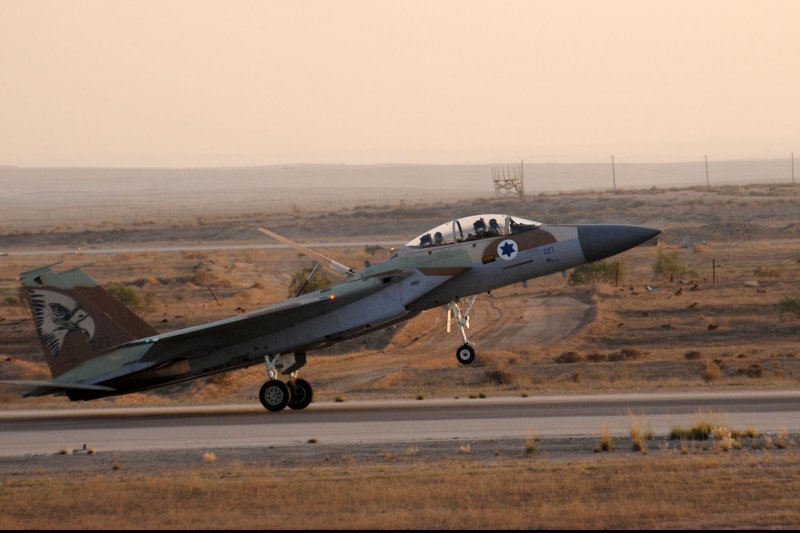An Israeli Air Force fighter jet lands during an air show in 2013. Israel has been attacking suspected Hezbollah arms consignments by air since January 2013. File Photo by Debbie Hill/UPI |
License Photo
BEIRUT, March 27 (UPI) -- Israeli warplanes carrying out airstrikes on a shipment of Iranian arms to Lebanese Hezbollah guerrillas in Syria managed to evade Syrian air-defense missiles but the incident is a graphic demonstration of how the war has the potential to further inflame the region.
There are likely to be further Israeli airstrikes against Hezbollah in Syria, reflecting deepening Israeli concerns that Iran's Islamic Revolutionary Guards Corps and their Lebanese ally are establishing a new front on the divided Golan Heights from which to fight the Jewish state.
These developments are increasing the chances of a miscalculation that could trigger a war that both sides insist they do not want. As tensions mount amid an unprecedented cluster of interlocking conflicts across the hair-trigger region, clashes like the aerial action over Palmyra could easily escalate out of control.
The Israeli airstrikes climaxed after weeks of verbal threats from all sides, aggravated originally by the administration of U.S. President Donald Trump vowing to roll back Iran's influence across the Middle East.
Israel has signaled repeatedly that it would not allow Iran to establish a permanent presence in Syria nor permit Hezbollah to obtain game-changing weapons, such as advanced air-defense systems, anti-ship missiles and long-range guided missiles.
Israel first launched airstrikes against suspected Hezbollah arms consignments in January 2013. Since then there have been at least 19 airstrikes, most of them in the Damascus area and further north in the Qalamoun region where there are a large number of Syrian military bases, including missile sites.
Israel's March 16 operation, involving four jet fighters, was its deepest strike inside Syria since 2013. The Israeli jets flew north over Lebanon's Bekaa Valley, Hezbollah's heartland, before entering Syrian air space and launching several missiles, reportedly at a convoy carrying unspecified weapons for Hezbollah.
The target was in the Palmyra area of northeastern Syria and several reports claimed the convoy originated from the T-4 airbase at Tiyas, west of the oasis town. In response, Syria launched at least four anti-aircraft missiles, believed to be relatively antiquated Russian-built SA-5s.
Syria claimed one aircraft was shot down and another damaged. Israel insisted all four aircraft returned safely.
Unusually, Israel deployed an Arrow anti-missile system for the first time in a combat situation to shoot down a Syrian missile that entered Israeli airspace. Fragments of the Arrow missile, which is designed to shoot down ballistic missiles at high altitudes, landed inside Jordan.
This, along with the air raid sirens and sound of explosions in the night sky above Jerusalem, apparently compelled Israel to publicly admit for the first time that its aircraft had struck targets inside Syria.
Israeli Prime Minister Benjamin Netanyahu made no secret that there may be more such attacks.
"When we identify attempts to transfer advanced arms to Hezbollah and we have intelligence information and we have the operational plan, we act to prevent it," he said. "That's what happened and that's what will happen."
The T-4 airbase is not an obvious location for gathering armaments destined for Hezbollah. It lacks underground facilities and is relatively distant from the Lebanese border. The main locations in Syria for Hezbollah arms repositories are believed to be in military bases near Adra and Qutayfah north of Damascus.
In the past, Iranian weapons for Hezbollah have supposedly been flown into Damascus airport or the nearby Mezzeh airbase. However, Israeli airstrikes at facilities at those locations as well as Qutayfah may have spurred Iran to seek to outmaneuver the watchful Israelis by using T-4.
Even so, T-4 is at least 175 miles from the Lebanese border over open terrain, making any arms vulnerable to Israeli interception.
In earlier Israeli airstrikes in Syria, Damascus either publicly condemned the attacks or ignored them. However, the question now is whether the decision to launch anti-aircraft missiles at the Israeli jets was a one-off gesture of displeasure or whether it marks a change in policy.
Bashar Jaafari, Syria's U.N. envoy, said the Palmyra strike "changed the rules of the game" and that Israel should "think a million times from now on" before staging more attacks.
Israel, however, continues to signal its determination to target advanced weapons destined for Hezbollah. Israeli Defense Minister Avigdor Lieberman warned after the March 16 clash that the Israeli Air Force would wipe out Syria's air-defense system if its jets were targeted again.
With the Assad regime gaining the upper hand in much of Syria against rebel forces and with Iran and Hezbollah eyeing the Golan as a springboard against Israel, the risk of miscalculation is growing.
Hezbollah and Israel know only too well from experiences dating to the 1990s how easily a minor incident can quickly escalate out of control — such as in July 2006 when a Hezbollah border raid in south Lebanon triggered a massive Israeli response that flared into a highly destructive 34-day war.
This article originally appeared at The Arab Weekly.















